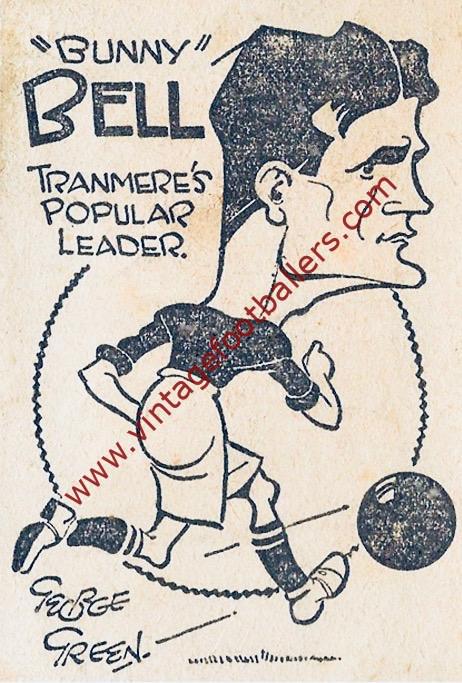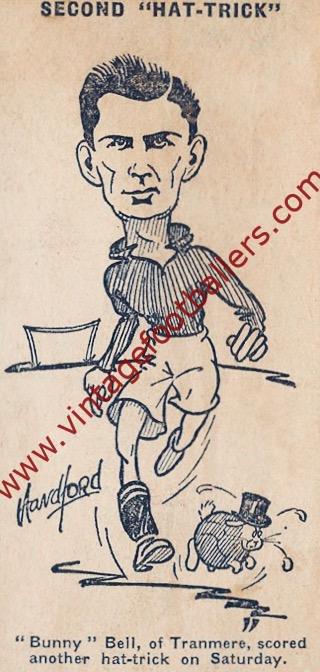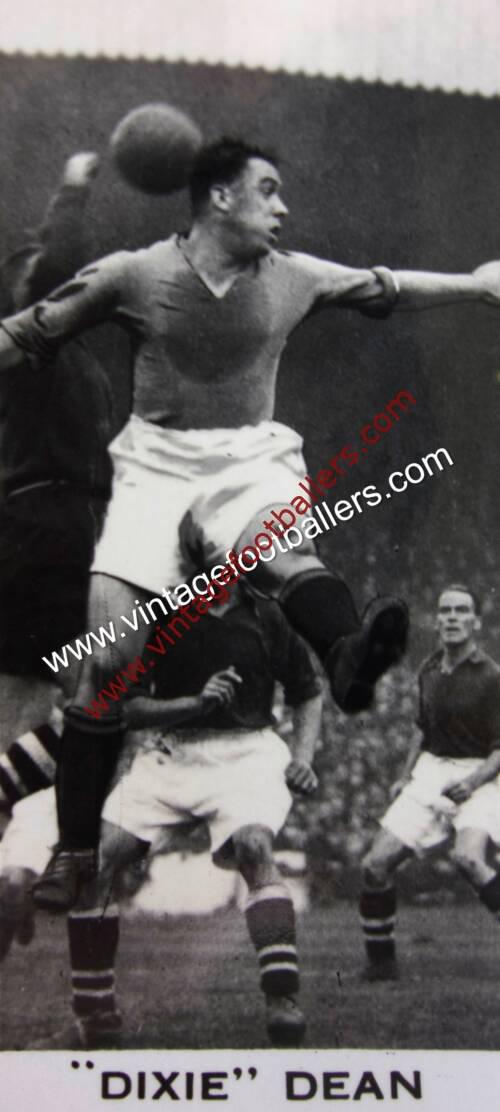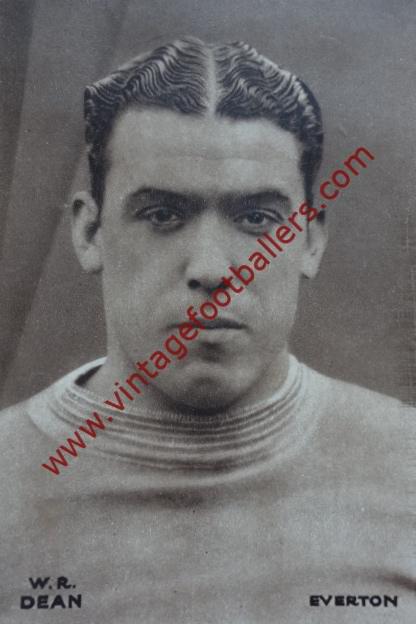Please choose your photo size from the drop down menu below.
If you wish your photo to be framed please select Yes.
Note: 16″x 20″not available in a frame.
Images can also be added to accessories. To order please follow these links
£8.95 – £49.95
Please choose your photo size from the drop down menu below.
If you wish your photo to be framed please select Yes.
Note: 16″x 20″not available in a frame.
Images can also be added to accessories. To order please follow these links
Birkenhead, Cheshire born centre forward Robert “Bunny” Bell holds a special place in football history. He began his football career with Carlton Athletic and joined local Third Division (North) club Tranmere Rovers in 1930, making his debut in an FA Cup tie at Gateshead that December, his only appearance of his debut season. He had to wait over a year for his Football League debut, coming after an impressive scoring run of 14 goals in 3 games for the reserves, which came against Barrow in February 1932, Bell scoring a brace in a 6-1 win. His first hat-trick for Tranmere came when he scored all three goals in a 3-1 win over Darlington in April 1932, and two weeks later he grabbed another treble in a win over Walsall to finish the season with 12 goals in only 11 matches.
Bell top scored for Tranmere Rovers in 1932-33 with 17 goals but it was the following season that he lit the blue touch paper, with 40 goals in 39 matches including 4 goal sprees against Barnsley and in an FA Cup tie against Newark Town and hat-tricks against Chester, Crewe Alexandra, York City and Halifax Town. Injury, including a fractured jaw and a broken collar bone, robbed him of much of the 1934-35 season but he still managed a hat-trick against Southport, and when he returned in September 1935 he had already scored 4 goals in a win over Accrington Stanley and a hat-trick against Stockport County when he achieved the feat for which he is always remembered.
On Boxing Day 1935, he scored nine times in Tranmere’s 13-4 victory over Oldham Athletic, at that time an English record. Rovers hit six goals within the first 19 minutes of play – Bell notching a hat-trick in the process. He added to his personal tally twice more before the interval, with the score reaching 8-1. A seventh Bell goal followed on 68 minutes. When a penalty was awarded to Rovers in the 73rd minute he had a gilt-edged chance to break the record for goals by a player in one match (seven), jointly held by Albert Whitehurst (for Bradford City against Tranmere) and Ted Drake (for Arsenal). Bob contrived to miss from the penalty spot but, with three minutes remaining, he coolly beat the Oldham keeper in a one-on-one to reach the landmark figure of eight. Then, in the dying moments he nodded home a cross to complete the triple-hat-trick. Hats were thrown in the air and, when the full-time whistle blew, members of the 11,500-strong crowd spilled from the terraces and chaired him off the pitch. Whilst he was subsequently changing, the exultant fans remained outside, chanting: ‘We want Bell!’
Four weeks later, a civic reception was held at Birkenhead Town Hall at which Bob was presented with the match ball, signed by players from both teams. The remarkable scoring feat brought a level of fame and ever closer attentions of centre-halves. It also put Bob firmly on the radar of bigger clubs. Before he finished the season, after 38 goals in 33 matches, and with Dixie Dean increasingly troubled by injuries, Everton signed Bell as cover on 13th March 1936 after 116 goals in 130 appearances for Tranmere Rovers.
Bee of the Liverpool Echo wrote of Everton’s new acquisition:
‘“Bunny” is still a mere stripling, so far as build is concerned; indeed, he has come to be known as the “invisible man” – so easily does he slip through defences! While he played with Tranmere, there were many followers of the club who could not take kindly to his style of play. He kept the line moving well, was less of an individualist than most “star” centres, and relied upon the half-chance for most of his goals. His heading is one of his strongest “lines” and he has scored many goals in this way. As an onlooker of most of Bell’s League football, I should say that he will need building up for the onerous duties of leadership in first class football. He suffered two severe injuries in a short space of time, having his cheek and collar-bone broken. There can be no pluckier forward in football. He has taken hard knocks and come back for more in a way that shows his heart is in the right place’.
Although the triple hat-trick record didn’t last long, Luton’s Joe Payne scored 10 in a match against Bristol Rovers in April 1936, Bell remains the only other player to score a triple hat-trick in a senior British fixture. he was signed by First Division club Everton in March 1936
Bell scored on his Everton debut in a defeat at Leeds United the next month and bagging a brace on his home debut in a win over Preston North End in May. However he was very much a fringe player at Goodison Park with the prolific Tommy Lawton ahead of him in the pecking order, and he played only 4 matches as Everton won the League Championship in 1938-39, although in one of those games he scored a hat-trick in a win over Leeds United at Goodison Park. The outbreak of the Second World War in September 1939 effectively ended his football career, by when he had scored 9 goals in 14 appearances for The Toffees, although he played on until 1946.
Bell deputised for Tommy Lawton in the 1939-40 wartime season, when the England striker was unavailable due to Army Physical Training Instructor duties. Memorably, after a run of matches for Everton, he was allowed to guest for his former club, when The Blues crossed the Mersey to Prenton Park on 23rd December. Everton, fielding a virtually full strength side, were too good for Rovers. Stork in the Echo reported: ‘Bell was keen to get a goal against his colleagues but he found the Everton defence too good for him, although his ideas, had they fructified, would have been decidedly useful.’ In fact Bob did bag a brace against his parent club but the Toffees netted nine times in reply. A few weeks later, Bob was back for the Toffees and scoring against Tranmere – such was the nature of wartime football.
Bell made a handful of appearances for Everton in the 1940-41 season but was not seen on the pitch again until the summer of 1945, when he resurfaced on 1 September 1945 in the Everton reserve team at centre-forward (this was the final season of the wartime league) but, after that, converted himself into a centre-half, perhaps to allow for his diminished pace. Lining up for the first team against Liverpool in the ‘pivot’ position he impressed Pilot of the Evening Express:
‘Bell revealed potentialities as a centre-half and Everton need worry about untrusting this erstwhile centre-forward with the pivotal task, for Bob knows the safety way.’ Ranger, in the same newspaper, echoed the sentiments: Considering Bob Bell has been out of first-class first football for so long I reckon he put up a great show.’
Back at centre-forward in a defeat of Manchester City in February 1946 (his penultimate first-team appearance), Bell scored twice and was hailed by Bee (Daily Post) for his application:
‘Bell always willing to tilt himself against all pivots, showed his brain was still functioning if his feet did not keep time with his thoughts. He is always getting goals. Not a showman; he just delivers the goods when Catterick is absent through illness. Can a centre do more?’Pilot, in the Evening Express, wrote: ‘The days of the “one-man-team” have passed for ever at Goodison Park. They are club men. Take Bob Bell as an example. Bob was called on at a late hour to take the place of flu victim Catterick and, although he has not been playing centre-forward much of late. He dropped into the scheme of things magnificently, and not only led the line splendidly, but banged a couple of goals.’
Days later, Bell lined up for Tranmere again at centre-half against Everton in the semi-final of the Liverpool Senior Cup at Prenton Park. Although Tommy Lawton had departed for Chelsea, Harry Catterick, eight years Bell’s junior, was the new regular choice at centre-forward. It was no surprise, therefore, that Bob was released at the end of the 1945-46 season, along with fellow former first teamers “Nat” Cunliffe and Douglas Trentham. Ranger, reporting on the departures, wrote: ‘The best known of course, is Bob Bell, who joined Everton from Tranmere Rovers in March, 1936, but has been unfortunate in having to play second fiddle to Dean, Lawton, and Catterick during most of his play at Goodison, though he has done the club good service in the Central League side.’ After leaving Everton he played for three years in his spare time at centre-half for Hoylake Athletic of the West Cheshire League.
| Weight | N/A |
|---|






